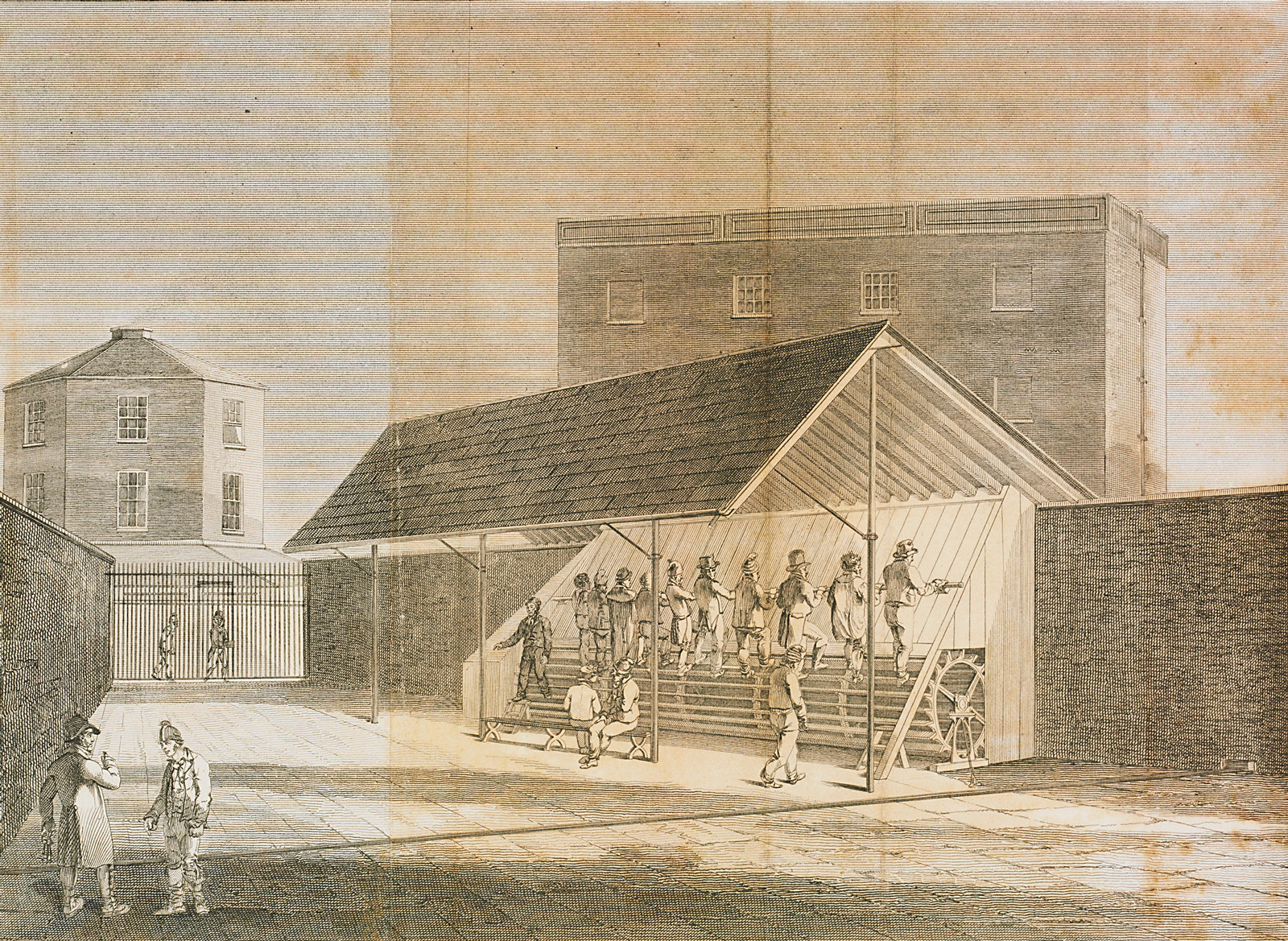David Sturrman
Chief, resistance fighter, Khoi hero
Arrived 1823 on Brampton
Chief of the Khoi of the Cape of South Africa, David Stuurman (also Steerman/Sherman) was a resistance fighter who had been captured by the British. First incarcerated on the notorious Robben Island, he was transported to New South Wales in 1822 with a life sentence.
Stuurman was accommodated at the Hyde Park Barracks while he laboured in a government gang. In 1829 he was granted his ticket of leave, but by this time he was lame in his right leg, and in February 1830 he died at the Rum Hospital. The Convict Death Register recorded no detail of the cause of his death. Stuurman was later portrayed as a hero of the Khoi resistance to British occupation of the Cape Colony.
In recent years, Stuurman’s descendants and current Khoi chiefs have requested to have his remains repatriated to South Africa. Many convicts who died at the Rum Hospital were interred at the burial ground near the Brickfields, but the 1901 resumption of the burial ground to build Sydney’s Central Station means that if Stuurman was once buried there, his remains cannot now be located.
More about Stuurman
Between the late 1820s until the early 1850s, while the colony was under British rule, at least thirty-four Khoisan prisoners were transported from the Cape colony at the Cape of Good Hope (now part of South Africa) to the Australian penal colonies. These cattle herders and Bushmen were almost all males. Khoi Captain David Stuurman was the most prominent amongst them.
Stuurman took on the hereditary mantle of Captain following the death of his brother, Klaas, the man who had pressed the Dutch to provide land to his people at the Klein River at the Eastern Cape. Significantly, this small enclave was the last freehold land at the Cape colony to be held by Khoi.1
Neither Khoi nor San people were ever enslaved by the British. They were, however, indentured as farm labourers. As a young man, David Stuurman was punished brutally by his master, farmer Johannes Vermaak. Stuurman was ‘tied to a wagon and beaten with sjamboks [whips]’. Stuurman’s suffering was compounded as he was ‘salted and left in the burning sun, for some hours’. When the farmer later died, a number of his Khoi servants, including Stuurman, abandoned the farm. Stuurman joined his brothers in a rebellion, a war that cost the lives of both Klaas and Andries Stuurman. After the war, in 1804 Stuurman’s followers settled on their land grant. Missionaries based at Bethelsdorp began to minister to the nascent community, treating it as an outstation of the London Missionary Society mission.
By 1809, the fragile accommodation between the small Khoi settlement and the surrounding Afrikaners was breaking down. Xhosa were impinging on the region, and distrust about potential alliances between Khoi and Xhosa loomed large in the colonists’ minds. Ultimately, Afrikaners destroyed the Khoi village, and took four prisoners – David Stuurman, his brother Bootsman, Cupido Michiel and Cobus Wildschut. The men were sent to Cape Town, and were accompanied by three of David Stuurman’s wives and seven of their children. Initially, the entire party was put into prison on the grounds that they had engaged in ‘suspicious conduct, living in a Kraal near the boundaries of the Colony’. Four of the Stuurman children died in custody. The men were shipped to Robben Island.2
At the end of 1809, a group of prisoners including the Stuurman brothers escaped from Robben Island. David Stuurman and two companions joined the Xhosa. Stuurman lived among the Xhosa throughout the fourth and fifth frontier wars and was not recaptured until near the end of 1819 after being at large for a decade. He was sent back to Robben Island at the end of December 1819. Following another escape in August 1820, Stuurman was recaptured and sentenced to be transported for life to New South Wales.3 Stuurman remained at the Cape following his 2 September 1820 trial through to February 1823 when the Brampton arrived at Table Bay. The transport had sufficient room to take on board convicts from the Cape.4
In February 1823 Stuurman and another Khoisan convict were put on board the Brampton along with twelve other convicts from the Cape. Two months later, on 20 April 1829, the convict transport arrived at Port Jackson. The indent prepared on board records that Stuurman was tried at the Cape of Good Hope and sentenced to transportation for life. His ‘native place’ was the ‘Cape’. Stuurman stood at just 5’3. His hair, eyes, and complexion were all described as ‘black’. His age was not recorded and his occupation was listed simply as ‘Hottentot’.5 The 1825 muster revealed that Stuurman was labouring in Sydney as part of a Government gang constructing much-needed public works during which time he was housed at Hyde Park Barracks.6
While Stuurman was in New South Wales, he was far from being forgotten by his relatives and supporters at the Cape. After returning from the Cape to England, Scottish poet and abolitionist Thomas Pringle published an article about ‘the circumstances that attended the extinction of the last independent kraal … of free Hottentots’ that exposed Stuurman’s plight. Sir Richard Bourke, who was Acting Governor at the Cape from 1826 until 1828, read the article and, according to Pringle, ‘immediately wrote to the Governor of New South Wales’. This intervention probably facilitated Stuurman being awarded his ticket of leave on 24 March 1829, at which point he had served only half of the required twelve years of a life sentence.7
Stuurman’s ticket-of-leave records details of his trial date and convict transport as well as providing a physical description. This time, his year of birth was given as 1773, with his ‘native place’ being ‘50 miles from Cape Town’. His height was 5’3¼” and his complexion ‘copper colour’. Stuurman’s once ‘black’ hair was now ‘black to grey and woolly’, his eyes ‘brown encircled in blue’, and he had a distinctive feature: he was ‘lame of the right leg’. By the time he had earned his ticket of leave, Stuurman had become a ‘labourer’.8
In 1827, New South Wales Attorney General Saxe Bannister began an eighteen month visit to the Cape where he met some of Stuurman’s surviving children at Bethelsdorp. He facilitated a petition from the Stuurman children to the Cape Governor Sir Lowry Cole to request the return of their father.9 When Richard Bourke returned to England near the end of 1828 he gained consent for Stuurman to be returned to his country and family provided that the Cape Government did not object. Several years later, in December 1831, Bourke relocated his family to Sydney to become Governor of the colony of New South Wales. He inquired about Stuurman only to find that the man had died the previous year, on 20 February 1830, at the General Hospital near Hyde Park Barracks in Sydney.10 Stuurman’s remains have not been able to be located.
This content was provided for the Convict Sydney website in 2017 by Dr Fiona Starr and expanded upon by Dr Kristyn Harman, Senior Lecturer, History & Course Co-ordinator, Diploma of Family History, School of Humanities, University of Tasmania.
Notes
- Vertrees Malherbe, ‘David Stuurman: “Last Chief of the Hottentots”’, African Studies, Vol. 39, No. 1, 1980, 50.
- Malherbe, ‘David Stuurman: “Last Chief of the Hottentots”’, 48-61; Clarke, Marcus. ‘Stuurman – Brothers, Patriots, and Hottentots’, Sydney Morning Herald, 6 May 1879, 7.
- Malherbe, ‘David Stuurman: “Last Chief of the Hottentots”’, 48–60; Leslie Duly, ‘“Hottentots to Hobart and Sydney”: The Cape Supreme Court’s Use of Transportation 1828–38’, Australian Journal of Politics and History, Vol. 25, Issue 1, 1979, 44.
- Malherbe, ‘David Stuurman: “Last Chief of the Hottentots”’, 60.
- Indent for the Brampton, 1823, NRS 12188, Bound Manuscript Indents, 1788–1842, 4/4003A, Microfiche 627, State Archives and Records New South Wales (SARNSW).
- David Stuurman, 1825 Convict Muster, Home Office: Settlers and Convicts, New South Wales and Tasmania; (The National Archives Microfilm Publication HO10, Piece 20), The National Archives of the UK (TNA), Kew, Surrey, England.
- Thomas Pringle, Narrative of A Residence in South Africa, Brentwood, Doppler Press, (1834) 1986, 84–85.
- David Stuurman, Ticket of Leave, NRS 12202, 4/4069, Reel: 911, SARNSW.
- Saxe Bannister, Humane Policy, or, Justice to the Aborigines of New Settlements Essential to a Due Expenditure of British Money and to the Best Interest of the Settlers with Suggestions How to Civilise the Natives by an Improved Administration of Existing Means, London, Thomas and George Underwood, 1830, 55; C H Currey, ‘Bannister, Saxe (1790–1877), Australian Dictionary of Biography, National Centre of Biography, Australian National University, accessed 20 September 2017 at
- Pringle, Narrative of A Residence in South Africa, 85; Convict Death Register, 4/4549, Reel 690, SARNSW.
Related

Convict Sydney
A world of pain
The combined aims of the assignment system, from 1826 onwards, were to equip farmers with cheap convict labour, to disperse convicts away from towns (and other convicts) and to keep an eye on each worker’s whereabouts and treatment
Published on
Convict Sydney
Browse all
Convict Sydney
Convict punishment: the treadmill
As a punishment, convicts were made to step continuously on treadmills to power wheels that ground grain

Convict Sydney
Molesworth report
The findings of the 1837 Molesworth inquiry brought about the end of convict transportation to New South Wales

Convict Sydney
Dennis Dogherty
Not even men in uniform were spared the gruelling punishment of transportation. Desertion from the military was regarded as a serious crime, as Irishman Dennis Dougherty found out

Convict Sydney
Francis Macnamara
With their ‘flash’ slang words, convicts could undermine the control of the authorities. The rebellious verse of Macnamara, who clearly had the gift of the gab, must have struck a chord with his fellow convicts
